Managing cultural diversity in the workplace of Amazon
Abstract
Cultural diversity is one of the major strategic factors where the multinational corporations try to develop effective tactics and working practice so that the diverse workforce can be managed well in the organisational workplace. The study aims at identifying the cultural diversity and its impacts on the organisation. The organisation chosen here is Amazon and through this study it is possible to analyse the organisational practice to manage cultural diversity. The literature review is effective in this project, where the theories such as Hofstede's cultural dimensions theory and Kandola and Fullerton mosaic model are effective to gain in depth understanding and develop knowledge about the field of cultural diversity. On the other hand, the review of literature provides a scope to identify the ways of managing cultural diversity in the workplace and its impacts on the organisation Amazon. The methodology chosen in this research is discussed in the third chapter and here the researcher will choose mix method for better analysis and evaluation. The findings and analysis chapter is effective to represent the gathered data and information where the researcher considers the employees and the managers of Amazon for collecting authentic data. The data analysis will be resented through applying the secondary information for further evaluation. Lastly, conclusion and recommendations would be effective to suggest suitable strategic planning to Amazon for better practice of managing cultural diversity. If you need a HRM dissertation help, we are here to help.
Acknowledgement

Conducting this research has been the greatest learning opportunity throughout the entire course for me; and it would have been not possible without the valuable, patient and constructive support, and guidance provided by my lecturer. His/her passion and commitment to teach further inspired me at a time when I felt totally exhausted and lack of confidence. I feel confident and prepared that my journey forward onto University to complete my course in Business Management will be a successful one. I wish to thank various people for their contribution to this research project. I would also like to thank my fellow classmates for making each and every day a challenge, as well as their support and encouragement during this project ad also I am blessed with supportive family members. I also get cooperation and support from the employees and managers at the human resource department of Amazon, who are the major participants in my research. Without their cooperation and response, it would be impossible for me to gather authentic and valid internal data and information to conduct this research with appropriate analysis and evaluation.
Chapter 1: Introduction
Cultural diversity is important in the workplace where the organisations try to manage theory diverse workforce and ensure high quality working practice in the company workplace for better management and leadership. The study focuses on managing cultural diversity in the workplace in order to evaluate the strategic planning and suggests effective tactics through which the organisation can develop effective way to manage the cultural diversity in long run. The study is on the organisation Amazon, which is a famous brand in the ecommerce industry. Cultural diversity management is one of the great concern of the leader and managers of Amazon in order to maintain their diverse workforce and create values for them in long run.
1.1 Rationale of the study
Cultural diversity management is mandatory for the organisations through which it is possible for the organisations to manage the diverse workforce irrespective of their cultural background, demographic, language, skill, gender and age (Mousa, Massoud and Ayoubi, 2020). There are many existing issues related to cultural diversity which arise problems or difficulties for the firms to operate internationally, due to mismanagement of the organisational workforce. Without effective cultural diversity management practice, it is not possible for the human resource department of the organisations to manage their internal issues and handle the strong team bonding in the workplace. In order to maximise team work and develop suitable organisational culture, it is mandatory to manage cultural diversity at the workplace. Hence, the study provides a scope to identify the practice of managing cultural diversity and critically analyse the strategies of the firm to manage their diverse workforce (Ravazzani, 2016).
The major issues related to cultural diversity are mismanagement, misunderstanding among the colleagues, non-cooperation, lack of communication among the team members, internal conflicts, poor team work activities, and resistance to change which are serious issues for the multinational corporations for which the performance of the organisation would be hampered. Due to these issues, the leader and the management team aim to develop suitable practice of managing cultural diversity at the workplace (Schlosser, 2019). Additionally, in the recent era of globalisation, there is high rate of migration of labourer across the international borders and there are a huge variety of employees from different skill, education background, cultural background and other differences exist among the employees (Schouten, Khattab and Pahng, 2020). This further influences the tactics of the leaders to manage cultural diversity at the workforce in order to handle the employees irrespective of the differences of the employees in terms of culture, demographic background, race and ethnicity, language, skill and gender and other disabilities (Kamales and Knorr, 2019).

Amazon.com, Inc. is an American based multinational technology company which focuses on ecommerce, digital streaming, cloud computing and artificial intelligence. Amazon is known as disruptive and well established industries through technological innovation and mass scale. It is world’s largest online market place, where the customers can get high quality and ensured products from Amazon at affordable price. It is one of the world’s most trusted and valuable organisations where the customers can maximise their satisfaction by choosing the ensured products which are high quality (Amazon, 2020). The major products of Amazon are Fire Tablet, Fire TV, Echo, Fire OS and Kindle. The services that the organisation provides are Amazn.com, Amazon Alexa, Amazon Appstore, Music, Amazon Prime and Amazon web series. It is also world’s fastest growing organisation in the ecommerce platform where the products and services are efficient to satisfy each customer around the international borders. The organisation is efficient to generate revenue and in the last year the revenue was $280.522 billion and the operating income was $14.541 billion. Total numbers of employees in the recent year is 840400 and net income of the company in 2019 was $11.588 billion. It is one of the famous organisation employed a huge numbers of employees across the globe (Amazon, 2020). The organisation is hereby efficient to stabilise their position in the international market through innovative products and last services in terms of technology, entertainment and other daily necessities of the customers. Hence, in order to manage the employees in different geographical areas, it is mandatory for the business to manage cultural diversity so that the diverse workforce can be handled efficiently at Amazon workplace.
1.2 Significance of the study
The major significance of the study is to identify the strategic tactics of the organisation Amazon in order to manage their cultural diversity at the workplace. The organisation as a famous international business hires the huge numbers of employees from different culture, race, ethnicity and diverse skill background (Shresha and Taylor, 2017). Thus, it is essential for the organisation to develop effective strategy for managing diversity at workplace as Amazon hires the employees from different country to manage their international operations. For the employees to be valued and engaged in the workplace, it is mandatory for the firm to respect each employee and manage them efficiently (Mateescu, 2017). Respecting each culture, value and ethnicity as well as treating all the employees are also necessary for Amazon to manage the diverse workforce and thus it is essential to develop suitable tactics for managing cultural diversity at the workplace of Amazon (Ayega and Muathe, 2018).
In addition to this, the study is helpful to analyse and evaluate the impacts of managing cultural diversity in the workplace as well as identifies the strategic planning, through which the organisational culture can be developed, where the leader and management team of Amazon would be able to handle the workforce and lead them towards achieving future success (Trieu, 2018). Hence, the study provides a scope to analyse and evaluate the practice and strategic planning of managing cultural diversity at the workplace as well as recommend some suitable suggestion for the firm Amazon to manage their international operations by handling diverse workforce (Hans, 2019). The study is hereby beneficial for the organisation Amazon to maximise their performance by managing the team irrespective of their cultural differences, values, ethnicity, race, gender and other disability. The study also gives the chance to conduct interview and survey among the participants of Amazon from which the researcher would be able to identify the tactics of Amazon in managing their cultural diversity as well as proposing suitable strategy to improve the workplace culture.
1.3 Aims
The aim of the research project is to analyse the strategic planning of managing cultural diversity in the workplace of Amazon. Through this study, it is possible for the researcher to evaluate the strategic practice and suggest suitable planning for managing the diverse workforce of Amazon across different places.
1.4 Research objectives
The objectives of the researcher are,
- To identify the cultural diversity issues at the workplace
- To gather theories and concept of cultural diversity
- To identify the strategic planning of managing cultural diversity at the workplace of Amazon
- To recommend some suitable suggestions to Amazon so that it would be possible for the leader of the organisation to manage cultural diversity at the workplace
1.5 Questions of the research
The research questions are such as,
- What are the existing cultural diversity issues at the workplace?
- What are the theories and concept of cultural diversity?
- What are the strategic tactics of managing cultural diversity at the workplace of Amazon?
- What would be the suggested recommendations for Amazon so that it would be possible for the leader of the organisation to manage cultural diversity at the workplace?
Chapter 2: Literature review
2.1 Introduction
Literature review is a fruitful chapter under this project, where it is possible to review the existing literatures and identify the authentic secondary sources of information for gathering in depth knowledge and data for this study. Through the literature review, it is possible for the researcher to demonstrate the research topic and analyse it efficiently after collecting relevant data and valid information. The literature review includes the theories and models of cultural diversity management at workplace, which further helps the researcher to improve own understanding and knowledge for further analysis and evaluation of the research topic. On the other hand, the conceptual framework is there which clears the framework of the research and helps the researcher to analyse the research topic after gathering authentic information and data. The literature review hereby provides a scope to gather knowledge and understanding through reviewing the existing theories and models on managing cultural diversity at the workplace.
2.2 Conceptual framework
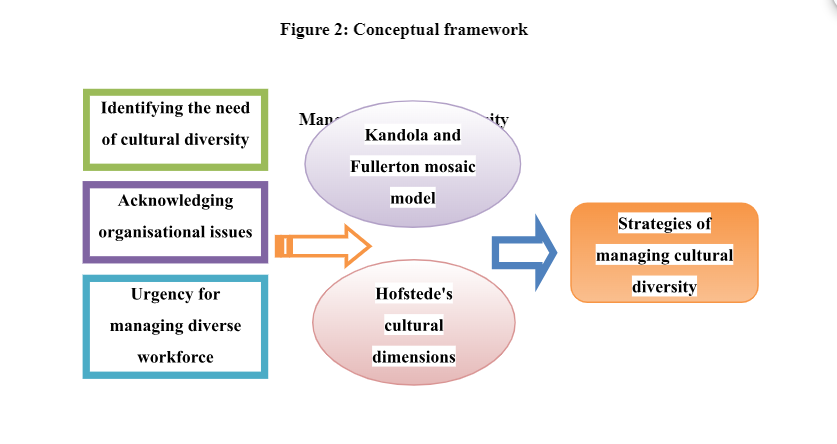
2.3 Cultural diversity
According to ANJORIN and Jansari (2018), cultural diversity is a phenomenon, where the employees from different cultural background work under the common circumstances and it is the role of the leaders to manage diversity at the workplace in order to treat all the employees fairly and give them fair opportunities in long run. As stated by Ahmed (2019), managing cultural diversity at the workplace is one of the major practices of the multinational corporations in the recent years in order to manage the diverse workforce and retain them of long run. in the recent era of globalisation, there is high rate of labour migration due to transfer of skilled workforce from one country to another for better production and manufacturing activities where the entrepreneurs utilise skilled labour for their organisational purpose. Hence, Kamales and Knorr (2020) opined that, managing cultural diversity is mandatory for the organisations in the recent era of globalisation for retaining the employees in long run and creates values for them. It is an approach of reorganising the organisational structure and develops employees intercultural competences further in the workplace of thee firms. The multinational corporations try to develop suitable organisational culture and create appropriate organisational structure in order to manage cultural diversity so that it would be possible to recruit the employees from different cultural background across different international borders. According to Ahmed (2019), cultural diversity is when the population differences are well represented within a community and these include race, ethnicity, age, ability, language, gender, religion, socio economic status, sexual orientation and nationality. As opined by Kamales and Knorr (2020), these are the major factors through which the cultural diversity has been recognised and it is the responsibility of the leader of the corporate firms to treat all the employees irrespective of their differences in language, cultural background, economic and social status and other abilities. The leaders also try to restructure the policies and practice to manage cultural diversity to treat the employees efficiently and manage them so that it would be possible to maintain diverse culture and manage strong team in the workplace.
2.4 Challenges in managing Cultural diversity
2.5 Kandola and Fullerton mosaic model
As opined by McCann, Sparks and Kohntopp (2017), the Kandola and Fullerton mosaic model is effective to manage cultural diversity at the workplace where according to the model, there are several strategic practices, through which the organisational leaders and the management team can handle diverse workforce and mitigate the organisational internal conflicts and misunderstanding among the team members. Organisational visions in this regard are mandatory to be developed and the leader must communicate the vision and strategies of the firm with all the employees. Additionally, According to McCann, Sparks and Kohntopp (2017), effective evaluation and clear accountability are also beneficial for the organisational leader to manage diversity at the workplace.

As opined by Ozgen, Nijkamp and Poot (2017), auditing and assessment needs generation, clarity of the objectives and sharing all the necessary information is also effective for the organisations to manage the employees and create harmony among them. In addition to this, the organisational leader focuses on coordination of activities, effective communication and managing the commitment towards their employees in order to handle them and lead them towards achieving future success. Roberson (2019) opined that, through these strategic planning, it is possible for the leaders and managers of the organisation to handle strong team and improve their inter-personal skill to work efficiently and achieve future organisational success.
2.6 Hofstede's cultural dimensions theory
According to Ozgen, Nijkamp and Poot (2017), Hofstede’s cultural dimension theory is effective to identify the organisational culture and manage the cultural diversity at the workplace. It is a framework for analysing different cultures of the international countries where the leaders and managers try to manage the organisational culture and reshape the organisational structure for working efficiently in long run. As per the Hofstede’s cultural dimension, there are different dimensions which are individualism, proper distance, certainty, achievements, time orientation and indulgence. These are the major factors through which it is possible for the organisations to reshape their practice and create suitable organisational culture to maintain cultural diversity in order to manage the strong team bonding in the workplace. As stated by Chia and Gibson (2019), individualism refers to whether the organisation or the country refers individual orientation or group orientation. In this regard, for managing cultural diversity at the workplace, the leaders try to create interdependence team work lading to group orientation so that the employees can perform under a suitable team. This is effective for managing tea work and create strong group in the workplace where every employees are treated equally. As opined by Schouten, Khattab and Pahng (2020), this is effective for the leaders to manage diversity and develop strong team bonding and trust among the employees irrespective of their diversities in language, skill, cultural background, race and ethnicity, nationality and others. Hence, group orientation is effective as per the Hofstede’s cultural dimension to manage cultural diversity at the workplace of the organisations.
Figure 4: Hofstede's cultural dimensions theory
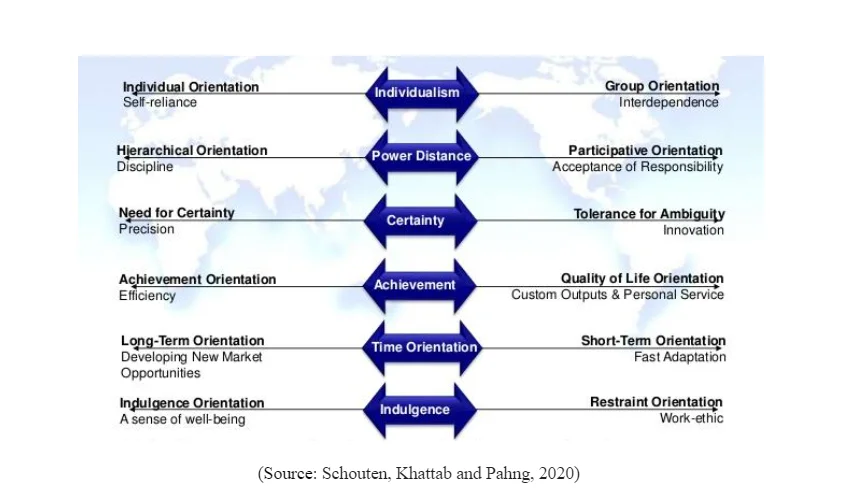
Additionally, according to Mousa, Massoud and Ayoubi (2020), power distance is another dimension through which it is also easy to identify the organisational practice and through this dimension, it is possible to identify hierarchical orientation or participative orientation in the workplace. Ravazzani (2016) opined that, for managing cultural diversity at the workplace, the organisational leaders and management team try to maintain discipline through creating hierarchical structure at the workplace as well as develop participative orientation, where the employees can participate in the organisational workplace efficiently. In this regard, the organisations try to accept responsibility of the individuals and give them equal chance to participate in the organisational workplace. Through effective participation and providing them the chance to talk about their skill and perception would be effective for the leaders to create diverse culture and encourage the staff members to manage their working roles and responsibilities efficiently. As stated by Mousa, Massoud and Ayoubi (2020), certainty is also effective for the organisational leaders where need for certainty or tolerance of ambiguity can be evaluated. In this context, for managing cultural diversity at the workplace, the organisational leaders try to be innovative and encourage the creativity of the employees as a whole, where all the staff members cam participate in the organisations for better working practice and this working practice further helps the organisation to manage cultural diversity at the workplace. On the other hand, Ravazzani (2016) stated that, the next dimension is achievement orientation vs. quality of life orientation. In this regard, the leaders try to focus on both the factors for achieving future success. Achievement orientation is effective to be focussed where the employees are motivated to increase their efficiency and achieve future success and fulfil the organisational values.
Moreover, as opined by Schlosser (2019), quality of life orientation can also be managed in order to maintain work life balance and improve the personal services. The employees are encouraged to manage their work life and improve their efficiency in long run. These are the strategies through which the leaders try to create values for the employees and manage cultural diversity by treating all the staff members in the workplace fairy. Kamales and Knorr (2019) stated that, time orientation also matters and ion this regard the leaders try to achieve long term goal of the organisation by developing mission and vision as well as the short term strategies are also achieved by fast adaption where the employees are engaged in the workplace. The leaders try to develop strong bonding and trust with all the staff and create values for them without concerning about their cultures, nationality, race and ethnicity. Indulgence refers to analyse whether the firm is towards indulgence orientation or restraint orientation. In this regard, Schouten, Khattab and Pahng (2020) opined that, the leaders try developing working ethics at the workplace, but mainly focus on indulgence orientation where it is possible to create a sense of wellbeing and it is possible for the leaders to handle cultural diversity by maximising the wellbeing of the individuals engaged with the organisation. Hans (2019) stated that, these are the major dimensions through which, it is possible for the leaders and the organisational management team to create a good corporate culture and manage diverse workforce across the world. Through creating good working practice and focusing on create values for all the employees in the workplace, it is easy for the leaders to handle the diverse workforce and lead them towards achieving future success.
2.7 Challenges with cultural diversity
According to Hopkins et al. (2016), in the recent era of globalisation, there are several challenges with cultural diversity in the organisational workplace and this further deteriorates the level of performance of the international firms in the market. Schlosser (2019) stated that, lack of communication and non-cooperation are the major two challenges due to cultural diversity at the workplace, where the firms fail to develop strong team bonding in the workplace. Due to cultural diversity, differences in race and ethnicity, language gap and diversity in skill set and attitude, the employees fail to communicate with each other and they also feel hesitated to interact with others at the workplace. Hence, as stated by Hopkins et al. (2016), lack of communication further hampers the overall performance of the employees where the staff members cannot interact with each other and it further deteriorates the pace of sharing knowledge and partnership working practice. Lack of cooperation is another challenge related to cultural diversity which is also another serious issue to hamper the organisational performance. Generating conflicts and internal misunderstanding are other issues related to cultural diversity, where the employees are not willing to cooperate with each other and misunderstanding rises among them. As opined by Hopkins et al. (2016), the partnership working practice and group building activities are also hampered for such issue and this deteriorates the overall performance of the organisations. Lack of trust and internal bonding as well as poor commitment and loyalty are also other problems related to the cultural diversity. Schlosser (2019) opined that, the organisational leaders and managers face difficulties to manage the cultural diversity at the workplace which further leads to more difficulties for the firm to make effective decision and achieve future success. Discrimination and legal ramifications are also other critical issues, which further hampers the working activities. High employee turnover as well as the resistance to change at the workplace is also other problems related to cultural diversity at the workplace for which the organisational objective scan not be met efficiently
2.8 Strategies of managing Cultural diversity
Hopkins et al. (2016) opined that, managing cultural diversity is an increasingly important component of the 21st century where the companies try to expand their business operations across the international borders and it is mandatory in this context to manage cultural diversity to welcome the employees from diverse cultural background, race, ethnicity, abilities and different languages. In this regard the leadership style and the existing policies play a crucial role in managing diversity at the workplace. According to Bendl Hainzl and Mensi-Klarbach (2019), the Equality Act 2010 is one of the rules which should be implemented in the organisation for managing the cultural diversity. Roberson (2019) stated that, the Equality Act is beneficial to enhance equal opportunities where the leaders treat all the employees equally irrespective of their cultural and demographic background, race and ethnicity, skill differences and language. This practice helps the employees to feel valued and encouraged in the workplace. In addition to this there are non-discrimination policies and practice, where every member is treated fairly and there is no discriminatory practice at the workplace. As stated by Tompos and Ablonczy-Mihályka (2018), the gender equality is also effective to enhance cultural diversity management practice, where the organisational leaders and managers hire both male and female for leading the company towards achieving future success. Additionally, the non discriminatory practice is also effective to treat the employees with disabilities efficiently where the staff members are also feeling valued under suitable organisational culture and structure of the management. As opined by Emeh, Njoku and Ukenna (2017), apart from the rules and legislations, the leadership practice is another strategy to manage cultural diversity and in this regard, the leaders must provide equal opportunity to each employee and engage them in the workplace. Ahmed (2019) opined that, equal treatment as well as managing transparency and accountability are effective strategy to handle diverse culture. Commitment towards each staff, engagement, counselling sessions and orientation program are also other tactics of managing cultural diversity at the workplace.
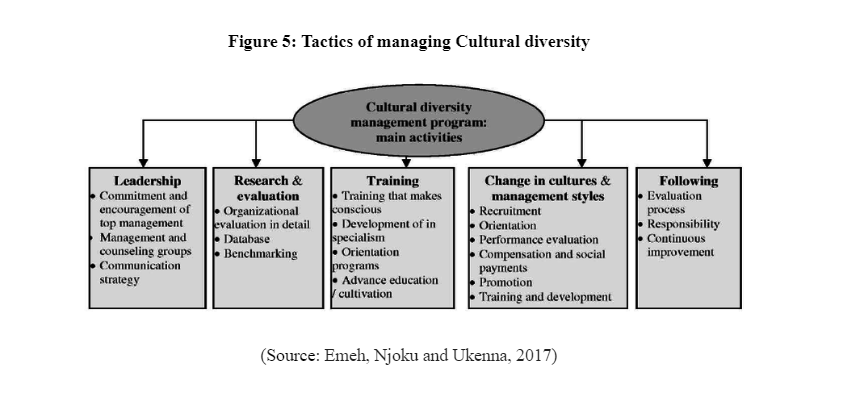
Additionally, as stated by Alnaqbi and Castillo (2017), the leaders try to use common language for interacting with the employees as well as arrange cultural training where the employees can improve inter-personal skill and emotional intelligence. Singh (2018) stated that, this training is effective where the staff members can interact with each other openly and share their views for better relationship building. Corporate relationship, trust and loyalty can be improved among the staff members through this practice. The leaders and the management team are also trying to share the organisational vision with each employee and improve internal communication. The leaders also try to develop strong team with high interaction and cooperation. According to Butcher (2016), highly collaborative working practice as well as partnership working is beneficial to manage cultural diversity where the employees are encouraged to have one to one interaction and communication with the colleagues and senior managers for better working practice. Hence, the organisational culture and leadership style play a crucial role in managing diverse workforce in the organisational workplace. Inclusion and diversity are mandatory where each member can get equal chance to participate and be engaged in the organisational decision making behaviour. As opined by Trieu (2018), employee relationship management as well as empowerment of the staff are also effective for handling diverse workforce. Promotional activities, recognition at the workplace on the basis of performance as well as the promotion to higher position irrespective of the gender and race are also efficient organisational practice to manage cultural diversity. On the other hand, Mateescu (2017) opined that, the organisational leader also enhances the practice of right behaviour, positive body language and improving understanding among the employees about different cultural background, race and ethnicity so that the staff members can respect each other’s culture and treat their colleges with respect.
2.9 Benefits of managing Cultural diversity
According to Ayega and Muathe (2018), the cultural diversity management at the workplace of the organisation is mandatory rot h leaders and the management team to handle the diverse team and retain the experience staff for long run. It raises the trust and internal bonding among the team members where all the members are treated equally. The members feel valued at the workplace and engaged with the organisational leader and management team. As stated by Shresha and Taylor (2017), the managers can strengthen employee base and encourage the creativity and innovation of the staff for long run. Hence, the organisational innovation can be improved by managing cultural diversity, where the team members start working efficiently and be motivated at the workplace. The managers and leaders are also successful to retain diverse culture and attract more diverse talent pool for the organisational benefits and this further provides a scope to the organisations to manage their innovation and encourage employee’s creativity in long run. As opined by Gottardello (2019), through the strategies of managing cultural diversity, the leaders try to maximise the organisational decision making behaviour and achieve future organisational success. The employees are also motivated and all the employees can cooperate and communicate with each other. With the cultural diversity management, internal communication can be enhanced where the employees are encouraged to interact with each other and share their perception with their colleagues freely. The organisations also can enhance partnership working practice through managing cultural diversity, where the employees start working collaboratively and fulfil their roles and responsibilities efficiently.
In addition to this, as stated by Lambert (2016), managing diversity at the workplace is effective for the organisations to increase inter-personal skill of the employees which increase the abilities of the employees to perform cooperatively and maximise the organisational mission and vision. Moreover, increasing team work and enhancing the firms innovatively can be possible through managing diversity at the workplace. Hans (2019) stated that, the leaders and managers can welcome different attitudes and behaviour as well as improve the variety of spoken owners where the staff members can interact with each other and maximise their contribution in the workplace. As opined by Bui and Eguaikhide (2019), growth of the company and credibility can be maximised as well as increasing productivity of the firms is another benefits of managing cultural diversity. Hence, managing diversity at the workplace is advantageous for the leaders to engage with all the employees and create values for them by treating them fairly, maximising their needs and preferences as well as encouraging them to perform better with high cooperation and communication. Gröschl and Bendl (2016) opined that, it is mandatory for the leaders of the internal companies to manage cultural diversity to hire the employees from different cultural background, diverse skill set and language differences which help the leaders to develop a strong team with loyalty and trust to maximise the organisational objectives.
2.10 Summary
The literature review is good for gaining in depth understanding and knowledge on cultural diversity management where the researcher is able to improve the skill and understanding about the strategies managing diverse workforce in the organisational workplace as well as review the theories of cultural diversity to strategise the business firms further. The literature review is also effective where the researcher is able to analyse further data and information and evaluate firms strategy to manage diverse workforce. Through gaining understanding on cultural diversity, the researcher also will be able to recommend some suitable suggestions for the firm and fulfil the above mentioned research aim and objectives successfully.
Chapter 3: Research methodology
Research methodology is important for the researcher to conduct the study in a systematic process by choosing the right methods of data collection and analysis. The research onion in this context is the best way to choose the right method and tactics of conducting the research related to cultural diversity. The research onion has proper layers of choosing the best methodology and according to the research onion, the layers are such as research philosophy, approach, strategy, data analysis and data collection method which are effective to develop suitable process to complete the research objectives and fulfil its aim (Brannen, 2017).

3.1 Research philosophies
Research philosophy is of three types which are interpretivism, realism and positivism. Positivism research philosophy is a way of conducting the research by demonstrating the phenomenon related to the research topic (Morse, 2016). In this regard, the human thoughts and data collected from human being are incorporated in the study, so that the human behaviour can be implemented for further analysis and evaluation. On the other hand, the realism research philosophy is related to incorporating the human mind set and the real life activities to identify real situations, and social interactions in the research (Brannen, 2017). On the other hand, the interpretivism philosophy is related to integrating the human interest and interpreted the findings for further evaluation and conclusion (Brannen, 2017). In this regard the researcher will choose positivism research philosophy in order to progress in the research and complete it successfully. It helps the researcher to acknowledge the human thoughts and incorporate the findings in the research for analysing the above mentioned research topic.
3.2 Research approaches
Deductive and inductive approaches are the major two types of research approach through which it is possible for the researcher to complete the study efficiently. The deductive approach is effective where the researcher tries to identify the existing theories and concepts related to the research topic (Morse, 2016). This research focuses on managing cultural diversity in the workplace and thus it is effective for the researcher to identify the existing theories and models related to cultural diversity management (Brannen, 2017). After reviewing the literatures, the researchers try to identify the human thoughts and real life experiences of the participants to analyse the findings for further evaluation (Brannen, 2017). On the other hand, the inductive method is different from the deductive one. Under the inductive approach, the researchers try to develop or create the theories and models related to research topic after analysis and evaluation. The researcher first conducts data analysis and evaluation and then develops the theories and models. In this research, the researcher will choose the deductive approach, for analysing the findings after gathering the existing theories, data, and models related to cultural diversity. The deductive approach is suitable for this study to identify the theories of cultural diversity and then analyse the collected data and information for better evaluation and fulfilling the above mentioned research objectives.
3.3 Research method
3.4 Data collection
There are two types of data collection method which are primary and secondary which helps the researcher to gather authentic sources of information and data for better analysis and evaluation. As per the primary data collection method, the researcher can collect the data directly from the first hand sources where the respondents share the information and give feedback about the research topic (Brannen, 2017). On the other hand, the secondary data collection method is related to collecting the data and information from the secondary sources of information including journals, books, articles and news papers are the authentic sources of collecting the secondary data. In this research, the researcher will choose both the primary and secondary data collection method for gathering authentic information and data (Brannen, 2017). Through the primary data collection method, the researcher will be able to collect the organisational information about the strategies of managing cultural diversity at Amazon. This is effective for understanding the internal working practice at Amazon and analyse the research topic efficiently. On the other hand, the secondary data collection will also be chosen by the researcher, where the existing secondary data including theories and models of cultural diversity will be effective for gaining in depth understanding about the research topic and analyse the findings by applying the theories and concepts of cultural diversity. Hence, both the data collection methods are effective for this research for in depth analysis and evaluation through collecting first hand information as well as secondary sources of information about cultural diversity.
3.5 Data analysis
There are two types of data analysis technique, which are quantitative and qualitative through which it is possible to evaluate and analyse the gathered data and information. In this regard, the quantitative data analysis is related to analysing the gathered data through graphs, charts and statistical models and analytical tools (Brannen, 2017). On the other hand, the qualitative data analysis is mainly to evaluate the gathered data on the basis of the secondary information, theories and models (Brannen, 2017). This is one of the effective ways to analyse the data and information and conduct in depth research for analysing the above mentioned research topic. In this regard, the researcher will choose qualitative data analysis method, where the analysis will be done on the basis of the secondary sources of information. However, the data will be represented through tabular formation and charts for identifying the feedback of the participants. This mixed method will be effective for this research, where the researcher will be able to analyse and evaluate the research topic efficiently for fulfilling the research objectives.
3.6 Sampling method
Sampling method is essential to choose the right respondents in order to manage the research and collect the valid data and authentic information for the study. In this context, the researcher will select the semi structured survey with different questionnaire so that it would be possible to collect authentic information directly from the representatives of the organisation (Morse, 2016). In this regard, the researcher will include 50 employees of Amazon which will be one of the effective ways to collect their feedback about managing cultural diversity at the workplace. This strategy of survey questionnaire is fruitful for the researcher to collect feedback and authentic information about the internal strategies of managing cultural diversity at the workplace of Amazon. On the other hand, the random sampling method is good for distributing the questionnaire among the employees of Amazon and convincing them to take active part for giving answer to each question properly. On the other hand, the researcher also tries to arrange interview with the managers at Amazon in order to identify authentic information about the organisational practice towards cultural diversity management. The researcher will select 3 managers at human resource department for identifying their feedback about the organisational strategy towards inclusion and diversity management. The interview questions will be arranged for gathering their data and information and it would also be beneficial for the researcher to conduct the study and analyse the above mentioned research topic.
3.7 Ethical consideration
Research ethic must be followed by the researcher in order to complete the study ethically. The researcher considers relevant and valid data to conduct the research with in depth analysis, where Authenticity and reliability of the data are managed by collecting the data and information from the valid sources, which further helps to analyse and evaluate the research topic efficiently (Morse, 2016). On the other hand, Data Protection Act 1998 is implemented in this research where the researcher tries to protect the data from the unauthorised access and ensure that the data will be utilised only for this study. The research also does not force the respondents to take active part in the survey rather the researcher tries to convince them to provide their feedback for research purpose. The managers are also convinced. The researcher maintains politeness and respects each respondent for their valuable feedback which would be effective for this study to conduct in depth analysis and evaluation. In the recent pandemic era for COVID 19, the researcher tries to distribute the questionnaire online as it is mandatory to maintain social distancing and it is not possible for the researcher to meet the participants or interact face to face with the managers of Amazon for the interview. Thus, the online survey and telephonic interview are arranged in this case to maintain research ethics and cooperate with them properly to gather authentic and valid data for further data analysis and evaluation.
Chapter 4: Findings and discussion
4.1 Introduction
Data findings and analysis is one of the major chapters of the project through which it is possible to represent the findings and analyse it further by utilising secondary information and knowledge of the researcher. In this chapter, the primary data will be represented where tabular form and charts are utilised to represent the survey data as well as there is interview transcript for discussing the findings collected through the interview with the managers of the organisations. After that, data analysis will be presented for evaluating the gathered data and findings.
4.2 Data findings
Survey questionnaire
1. Leadership of Amazon supports the firm’s value of diversity and inclusion
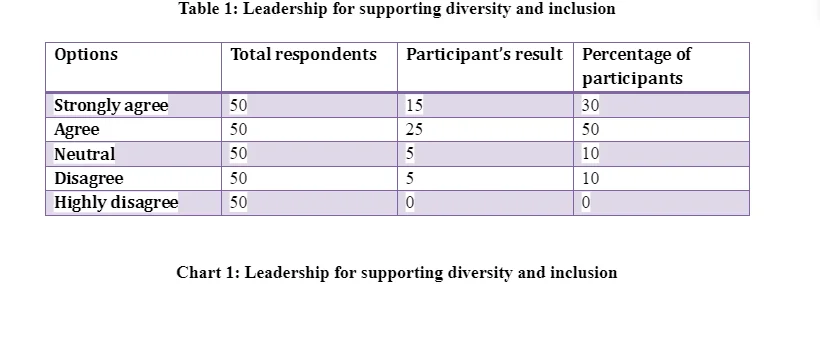

As per the findings, 30% employees strongly agree that Amazon leadership is good for managing diversity and inclusion and where additional 50% members also agree the same. 10% members gave neutral answers and rest of the employees disagree the same. Hence, most of the employees are happy with the organisational leadership style of diversity and inclusion management. The leader of Amazon focuses on managing cultural diversity in order to handle their international operations and in this regard inclusion of all employees and diversity are the strategies through which the leader aims at managing diversity at the workplace.
2. People from different cultures and backgrounds are respected and valued in the workplace


20% and 44% employees strongly agree and agree to the fact that the individual from different cultural background get fair treatment and get respect from the management team and colleagues. Whereas, 16% staff gave neutral answers and rest of the members disagree to the fact. As per the findings, most of the individuals at the workplace of Amazon agree that there is diversity management practice and the employees are valued irrespective of the diversity in cultural background, social economic status, language, skill set, education and abilities.
3. Our firm Amazon is committed to diversity and inclusion
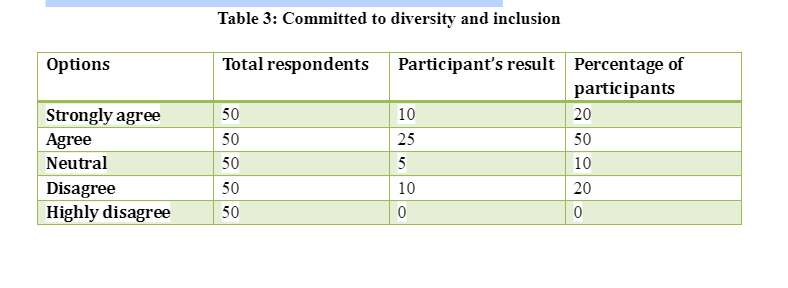

As per the findings, 20% and 50% staff members strongly agree and agree respectively to the fact that Amazon is a great place where the leader is efficient to manage the practice of diversity and inclusion. Whereas, 10% gave neutral answers and 20% members disagree the statement. Organisational commitment is mandatory to be handled and in this regard most of the employee agrees that Amazon creates values for the staff members where the leader is also efficient to fulfil the commitment towards the employees.
4. Employees with disabilities are treated fairly


According to the findings, again 50% employees gave neutral answer for which it is not predictable for the researcher to analyse the internal situation. However, 10% members strongly agree and 26% members agree that the employees with disabilities get fair treatment at the workplace of Amazon. 10% members disagree and 4% strongly disagree the statement. Though the firm does not have additional strategies to handle disabled individuals in the workplace and there is lack of disabled employees in the workplace of Amazon, the leader follows equality and diversity management to treat all the staff members fairly.

5. I feel included and respected within the firm

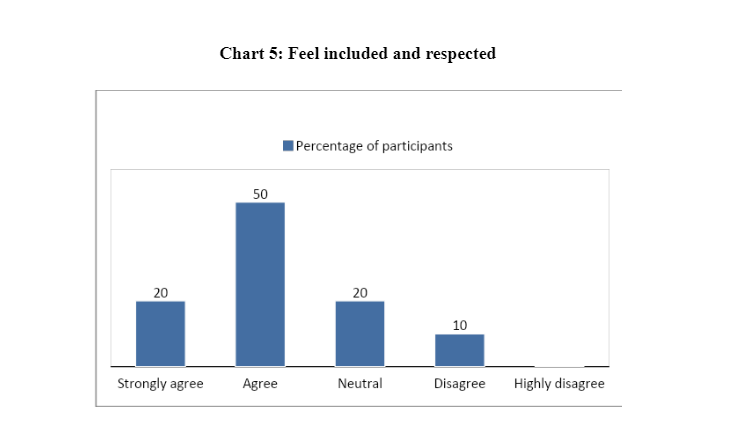
Inclusion and respecting each other at the workplace are the factors contributing in managing cultural diversity at the workplace. 20% gave neutral answers and 10% gave negative answers to this statement. However, there are positive answers where 20% staff members strongly agree and 50% members agree to the same that they are empowered and they respect others culture, ace, ethnicity, language and values. The managers and the leader of Amazon refer to treat the employees equally and for which the members feel valued and respected at the workplace. The members also create good environment where the employees give value to others culture and heritage so that every staff members can feel important and contribute efficiently in the organisational performance.
6. I feel empowered and free to express my thoughts in the workplace


Empowerment at the workplace and feeling free to express own feedback in front of others are also essential for managing cultural diversity and creating values for the employees. Most of the staff members at Amazon agree that they are embowered and they can share their decision with the management team as per their understanding. However, 40% gave neutral answers and 20% do not agree with the same statement. Empowerment is one of the strategies of the leader for enhancing the organisational creativity and innovation and thus the employees agree that they are empowered in the firm, where they can express their decision and thoughts in front of others and influence the organisational decision making behaviour.
7. I am comfortable talking about my cultural background with my colleagues
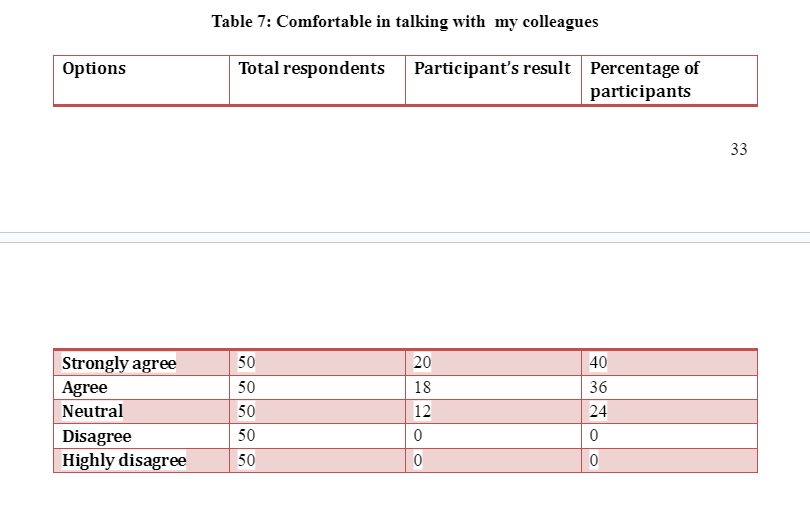
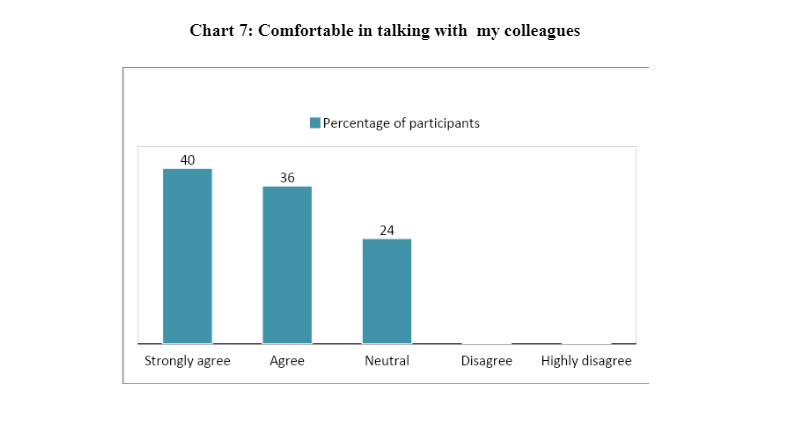
Talking comfortably with the colleagues is mandatory for the employees to feel free and share their feedback with each other for working as a team. In this regard, the data reveals that 24% employees give neutral answers for which it is unpredictable for the researcher to identify the internal situation. However, rest of the employees agree that they can share their perception with their colleges and they try to work as a team by discussion and enhancing communication. Most of the employees agree that they are comfortable in communicating with others and the managers in this regard play a crucial role to enhance internal communication for providing suitable workplace where the staff members can interact with each other freely.
8. Management demonstrates a commitment to meeting the needs of all employees
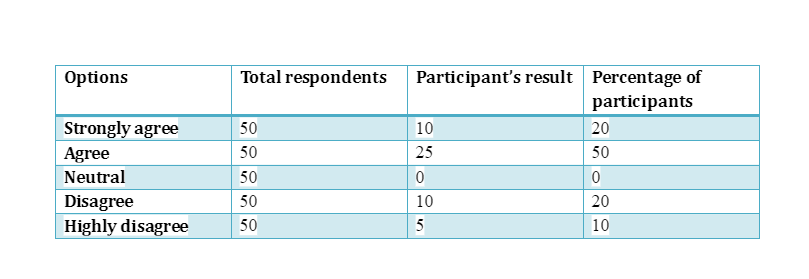
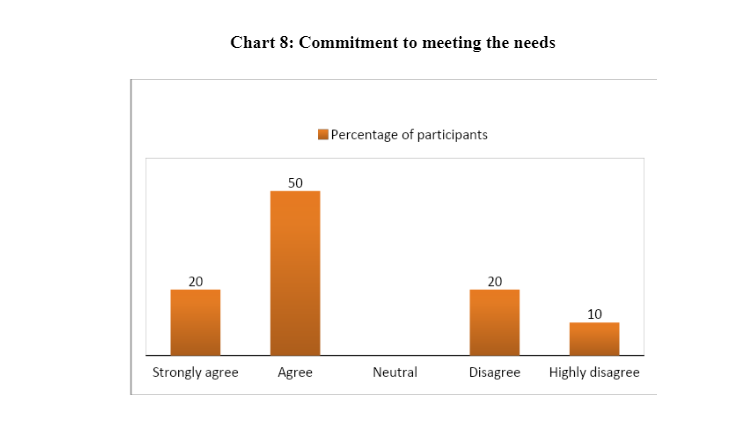
According to the above finding, it is seen that most of the employees agree that the management team is efficient to meet the personal needs and preferences of the employees at the workplace. The leadership style of Amazon is good to create values for the staff at the workplace. Though there are some employees about 30% who do not agree to the same. The needs and preferences of the employees are met at the workplace; however there are some employees who are not happy with the organisational promotional activities and recognition.
9. There are both male and female members empowered in the workplace
Table 9: Equality in gender


20% employees provide neutral answer. 36% staff members are against equality of employing male and female members in the workplace. And the rest of the employees agree that there is equality in hiring male and female members at the workplace. The staff member stated that in the higher position of the organisation Amazon, there is lack of female members and this further arise the issue of equality and diversity. There is mismanagement of recruiting the female members as equal as the male members recruited in the workplace.
10. Equality standard is followed by the firm Amazon
Table 10: Equality standard

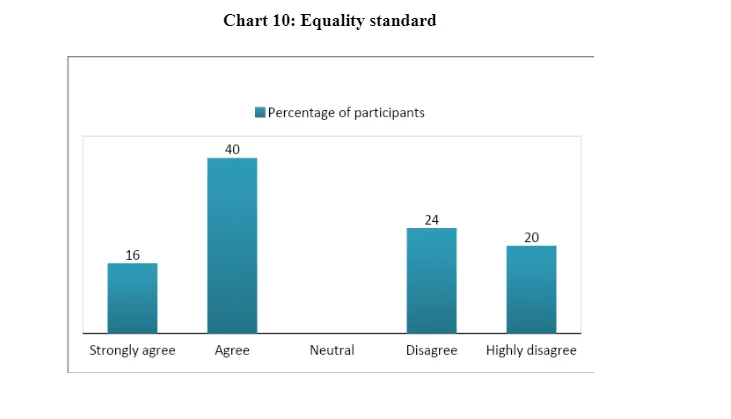
As per the findings, most of the employees agree that Amazon follows equality standard at the workplace where male and female as well as all the employees irrespective of their culture and language are treated equally. Thus, Amazon is an effective workplace for the employees to get equal opportunity for performing better. Due to lack of fair promotional activities and absence of equal male and female members in the higher position of Amazon, the employees feel that equality standard is not met by the organisation.
Interview transcript


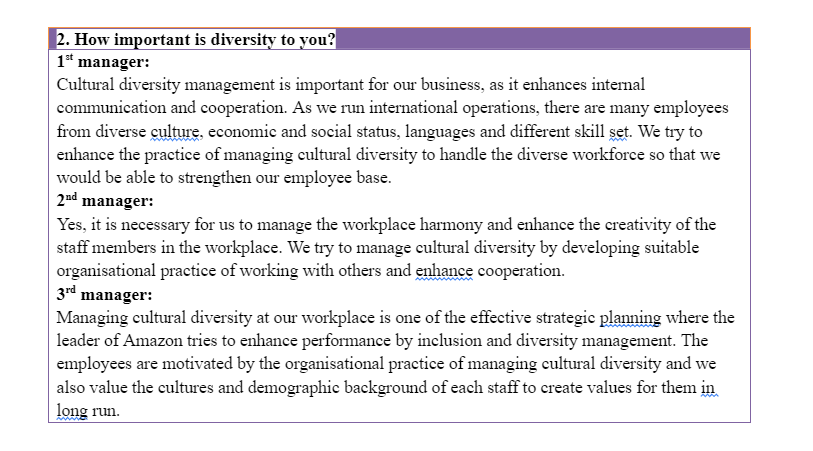


4.3 Data analysis and discussion
As per the above findings, the employees are happy with the workforce activities and leaders perception where the diversity and inclusion are managed well in the workplace. As Amazon is a global brand, it is mandatory for the leader to manage cultural diversity and in this regard the employees also feel that they are valued in the workplace. The management team are efficient to create values for the employees and manage them successfully. For managing the diverse culture, the leaders try to maximise the basic needs of the staff and create values for them. The leader focuses on respecting each members and respect their values, cultural background, language and own perception. The employees also revealed that, the organisational practice towards equality and diversity is also there where the employees are treated fairly and respect each other. According to the findings, the employees also can discuss their opinion and perception with their colleagues freely and there is no such barriers of communication, open discussion and high interaction among the employees will help them further to develop strong bonding and understand each other for better working practice. Hereby, the employees agree that the leaders of Amazon are good for managing diversity and inclusion where they are treated equally. The employees also feel valued at the workplace as there is no communication gap and they have the opportunity to discuss their opinion with others and get empowered (Amazon, 2020). Most of the employees feel that Amazon is a great place to work, but there are few members who are not satisfied with the inclusion and diversity practice of the organisation (Tompos and Ablonczy-Mihályka, 2018). It is difficult for them to work in the diverse culture and get accustomed with the organisational strategic practice. It is mandatory for the organisational leader to develop further effective practice and rules of managing cultural diversity so that each member at the workplace feel valued and they can contribute efficiently with their full capabilities.
The analysis revealed that, some of the employees are also not satisfied with the equality act implemented in the organisational workplace. They also agree that there is lack of equality in hiring the male and female members. The numbers of male employees in the workplace is naturally higher across the international workplaces of Amazon as compared to the female members. It further gives the chance to the employees to think that there is lack of equality management in recruitment of the employees. Moreover, in the higher position of the organisation, there is lack of female members or officers or managers in Amazon which also raises the issue of equality in the organisation for which the few members does not agree that leaders of among is successful in managing equality and diversity at the workplace. Apart from that, there are low chances for the disabled people in the workplace for working office desk tasks or any operational tasks in the organisation which is also another issue of recruitment and selection of the employees across different branches of Amazon (Amazon, 2020). It would be beneficial for the organisation to work with others and develop further strategic planning in order to manage diverse workforce (Shresha and Taylor, 2017). There are some employees who are not happy with the promotional activities and recognition which create the scope of mismanagement and misunderstanding among the members. For managing the organisational international operations, it is mandatory for the firm to handle the workforce efficiently and maximise wellbeing of the employees irrespective of their cultural background, demography, social and economic status, abilities and different skill set (Roberson, 2019).
As per the interview sessions, the first manager of Amazon stated that managing inclusion and diversity is mandatory for hiring the diverse workforce across the globe. As the business of Amazon is international and the leader focuses on hiring and recruiting the diverse workers irrespective of their skill set, cultural background and languages. Thus it is mandatory for the leader of Amazon to manage inclusion and diversity at the workplace in order to manage cultural diversity (Amazon, 2020). The second manager also reveals that, it is mandatory for handling the workers across the globe so that the workers can feel valued and important at the workplace. The third manager also agrees to the same for managing the diverse workforce (Schouten, Khattab and Pahng, 2020). Hence, it can be evaluated that, all the members of the management team of Amazon prefer to manage the cultural diversity and inclusion in the workplace for managing their internal operations. It is necessary for the organisation to include all the employees and create values for them by diversity management so that every employee can feel valued and their interest of working in the workplace will be increasing over time through social treatment and diversity management. Additionally, three managers at Amazon agree that cultural diversity management is mandatory for the business to run their international operations (Emeh, Njoku and Ukenna, 2017). The managers revealed that, through diversity management at the workplace, they are successful to enhance communication among the employees and it further boosts their performance where the employees can share their erections and skill as well as experience to increase their team work and capabilities. On the other hand, the manager also stated that, it is necessary to manage diversity at the workplace through improving cooperation which also helps the firm to handle their strong employee base in long run. Hereby, managing cultural diversity is good for the organisation to support the workforce and lead them towards achieving future success (Kamales and Knorr, 2020).
In addition to this, according to the interview transcript, the managers revealed that the organisational workplace is good to manage cultural diversity, where the leaders focus on enhancing internal communication and collaboration which is the major tactics to manage diverse workforce (Amazon, 2020). The organisational leader at Amazon tries to manage their international operations by developing good team work through enhancing communication, one to one interaction at the workplace and maximising cooperation (Bendl Hainzl and Mensi-Klarbach, 2019). The workers try to collaborate with each other for better practice and performance at the organisational workplace, hence, it can be seen that cultural diversity is handled by the organisation through communication where the employees are free to share their opinion and discuss with their colleagues irrespective of their diversities in terms of language, race and ethnicity, disabilities and skill set, this is one of the effective way to enhance cultural diversity at the workplace. Moreover, the organisation also focuses on sharing the important information and organisational data with the employees so that the staff members can feel important and valued at the workplace and they start contributing efficiently in the workplace, the leader of Amazon tries to share the organisational mission and vision with all the staff and develop strong bonding with them (Amazon, 2020). This further helps to enhance trust and loyalty among the team members which in turn provides a scope to manage cultural diversity at the workplace and manage the diverse workforce without any existing issues and misunderstanding (Hopkins et al., 2016). It is essential for the organisation to develop effective tactics to manage cultural diversity. The organisation is efficient to improve communication and cooperation, but there needs to develop better tactics for handling the diverse workforce (ANJORIN and Jansari, 2018).
5. Conclusion, recommendations and reflection
5.1 Conclusion
The analysis and evaluation indicates that, cultural diversity is mandatory for motivating the workforce and it helps the leader to develop suitable organisational culture and working practice for managing diverse workforce. As Amazon is a international organisation, it is mandatory for the leader and management team to manage their divers workforce as the numbers of employees recruited in the organisation is high and the employees are form different region, cultural background, language and skill set. This is hereby essential for the organisation to manage them and retain the employees for long run. Cultural diversity management helps the business to motivate the staff and ensure high performance workforce, where the employee s feel treated equality and valued at the workplace. The leader of Amazon mainly focuses on two major strategies which are enhancing internal communication and developing collaborative workplace. Theses ate the major strategy where the team members are treated equally and they are encouraged to develop strong team work in the workplace. High communication and cooperation are helpful or the employees to communicate with the colleagues and senior managers as well as discuss their thoughts and decision in the workplace. The partnership working practice and the internal communication are hereby effective where the organisation is able to manage their diverse workforce. Additionally the organisational leader also respects the different values, culture and beliefs across the international borders so that the employees in different region can be valued at the workplace and they can perform efficiently with their full capabilities.
5.2 Meeting the objectives
The study is effective to meet the above mentioned research objectives through in-depth data analysis and evaluation. The first objective is related to identify the cultural diversity issues at the workplace and as per the research project; the major issues are such as mismanagement and misunderstanding among the employees, high turnover rate, internal conflicts and resistance to change, which further deteriorates the organisational performance in long run. The second objective is to gather theories and concept of cultural diversity which is also fulfilled by reviewing the theories and concepts of managing diversity at the workplace by reviewing the secondary sources of literatures. The third objective of the research is to identify the strategic planning of managing cultural diversity at the workplace of Amazon, and it is also maximised by the above mentioned data findings and analysis. The major strategic planning of the firm Amazon is to maximise internal collaboration, enhance communication, give values and respect each member at the workplace irrespective of the cultural diversity. The fourth objective is to recommend some suitable suggestions to Amazon so that it would be possible for the leader of the organisation to manage cultural diversity at the workplace which would be proposed further.
5.3 Recommendation
- The organisation Amazon must focus on implementing the Equality Act 2010 as well as non-discriminatory practice for treating the employees fairly.
- Fair treatment and managing accountability and transparency is another strategy by the firm which further enhances internal bonding and trust among the staff members. Hence, creating corporate culture, with harmony, friendly relationship among the staff and managers in the workplace, open communication and discussion are mandatory for the leader to manage cultural diversity at the workplace and improve understanding.
- Amazon must focus on arranging cultural training program as it provides a scope to the employees to take active part in the training and discuss about their cultural background, abilities and skill set with others. This further raises emotional intelligence and improves the inter-personal skill of the employees across the workplaces of Amazon around the globe.
- Amazon must focus on recruiting the female members to maintain equality of hiring both male and female in the organisation. Moreover, the promotional strategy and recognition at the workplace must be fair so that the female and male members can get equal opportunity to get higher position in Amazon.
- The leader of Amazon needs to values each members and empower them in the organisational decision making behaviour and giving equal chance to be embowered for further inclusion and diversity would be beneficial for the firm to manage the diverse workforce and encourager their creativity to achieve organisational success.
5.4 Future research
The future of the study includes some aspects of more in depth analysis and evaluation about the major practice and rules of the organisations in managing cultural diversity at the workplace. The scope for the research on the field of cultural diversity management is huge where more in depth studies with high numbers of respondents and managers would be able to increase the clarity and depth of the research analysis and evaluation. The future researchers can invest more new skill set of the leaders and the new and effective leadership style that world be beneficial for the organisational leaders to manage their international workforce in long run.
Looking for further insights on Managing Complex Situations? Click here.
Reference List
Ahmed, M., 2019. Ethnic Diversity in the Workplace: The Good, the Bad, and the Ugly. Aisthesis: Honors Student Journal, 10(1), pp.10-17.
Ahmed, M., 2019. Ethnic Diversity in the Workplace: The Good, the Bad, and the Ugly. Aisthesis: Honors Student Journal, 10(1), pp.10-17.
Alnaqbi, M.M.A. and Castillo, F.G., 2017. Multi cultural diversity at national hospital: is teamwork possible?. European journal of economics and management sciences, (4).
Amazon, 2020. About us. [online] Available at: https://www.aboutamazon.com/?utm_source=gateway&utm_medium=footer [Accessed on 21 July 2020].
ANJORIN, R. and Jansari, A., 2018. Managing Cultural Diversity at Workplace.
Ayega, E.N. and Muathe, S., 2018. Critical review of literature on cultural diversity in the work place and organizational performance: A research agenda. Journal of Human Resource Management, 6(1), pp.9-17.
Bendl, R., Hainzl, A. and Mensi-Klarbach, H., 2019. Diversity in the Workplace. In Oxford Research Encyclopedia of Psychology.
Brannen, J., 2017. Mixing methods: Qualitative and quantitative research. London: Routledge.
Bui, L. and Eguaikhide, O., 2019. Institutional Resistance to Managing Workplace Diversity. Intercultural Communication in Business Environment, p.26.
Butcher, M., 2016. Managing cultural change: Reclaiming synchronicity in a mobile world. Routledge.
Chia, T. and Gibson, C., 2019. How Experiences with Diversity and Mindfulness Contribute To Inclusive Diversity Climates at Work. In 79th Academy of Management Annual Meeting 2019.
Emeh, N.C., Njoku, M.G.C. and Ukenna, S., 2017. Managing Cultural Diversity in Federal Broadcasting Establishments in South-East Nigeria. Journal of Management and Social Sciences, 3(1), pp.19-34.
Gottardello, D., 2019. Diversity in the workplace: a review of theory and methodologies and propositions for future research. Sociologia del lavoro
Gröschl, S. and Bendl, R., 2016. Rethinking Religious Diversity Management in Schools: Experience From Tanzania Gabriel Ezekia Nduye. In Managing Religious Diversity in the Workplace (pp. 179-198). Routledge.
Hans, V.B., 2019. Global Business and Cross-Cultural Diversity: Globalisation and Business Changes and Values. NOLEGEIN-Journal of Global Marketing, pp.18-31.
Hans, V.B., 2019. Global Business and Cross-Cultural Diversity: Globalisation and Business Changes and Values. NOLEGEIN-Journal of Global Marketing, pp.18-31.
Hopkins, W.E., Scott, S.G., Tung, R. and Froese, F.J., 2016. Values-based leadership effectiveness in culturally diverse workplaces. Cross Cultural & Strategic Management.
Kamales, N. and Knorr, H., 2019. Leaders with Managing Cultural Diversity and Communication. Asia Pacific Journal of Religions and Cultures, 3(1), pp.63-72.
Kamales, N. and Knorr, H., 2020. Leaders with Managing Cultural Diversity and Communication. International Journal of Development Administration Research, 4(1), pp.21-30.
Lambert, J., 2016. Cultural diversity as a mechanism for innovation: Workplace diversity and the absorptive capacity framework. Journal of Organizational Culture, Communications and Conflict, 20(1), p.68.
Mateescu, M.V., 2017. Cultural diversity in the workplace-discourse and perspectives. Modelling the New Europe. An On-line Journal, (24), pp.23-35.
McCann, J.T., Sparks, B.H. and Kohntopp, T.F., 2017. Leadership integrity and diversity in the workplace. Leadership, 2(5).
Morse, J.M., 2016. Mixed method design: Principles and procedures (Vol. 4). Routledge.
Mousa, M., Massoud, H.K. and Ayoubi, R.M., 2020. Gender, diversity management perceptions, workplace happiness and organisational citizenship behaviour. Employee Relations: The International Journal.
Ozgen, C., Nijkamp, P. and Poot, J., 2017. The elusive effects of workplace diversity on innovation. Papers in Regional Science, 96, pp.S29-S49.
Ravazzani, S., 2016. Understanding approaches to managing diversity in the workplace. Equality, Diversity and Inclusion: An International Journal.
Roberson, Q.M., 2019. Diversity in the workplace: A review, synthesis, and future research agenda. Annual Review of Organizational Psychology and Organizational Behavior, 6, pp.69-88.
Roberson, Q.M., 2019. Diversity in the workplace: A review, synthesis, and future research agenda. Annual Review of Organizational Psychology and Organizational Behavior, 6, pp.69-88.
Schlosser, E., 2019. An Investigation Into Western Tech Executive’s View of Cultural Diversity in the Workplace and the Implications for Individual Team Members (Doctoral dissertation, Dublin, National College of Ireland).
Schlosser, E., 2019. An Investigation Into Western Tech Executive’s View of Cultural Diversity in the Workplace and the Implications for Individual Team Members (Doctoral dissertation, Dublin, National College of Ireland).
Schouten, M., Khattab, J. and Pahng, P., 2020. Managing Team Diversity in the Workplace. In Oxford Research Encyclopedia of Business and Management.
Schouten, M., Khattab, J. and Pahng, P., 2020. Managing Team Diversity in the Workplace. In Oxford Research Encyclopedia of Business and Management.
Shresha, N. and Taylor, B., 2017. Cultural diversity in the workplace.
Singh, N., 2018. Prospective and Strategies Managing Cross Culture Diversity in Workplace. GST Simplified Tax System: Challenges and Remedies, 1(1), pp.166-168.
Tompos, A. and Ablonczy-Mihályka, L., 2018. The sustainability of cultural diversity in the workplace: Cultural values and intercultural mindset. European Journal of Sustainable Development, 7(1), pp.298-298.
Trieu, K., 2018. Finnish and non-Finnish students’ perceptions of cultural diversity in the workplace.
Appendices
Appendix 1: Ethics form
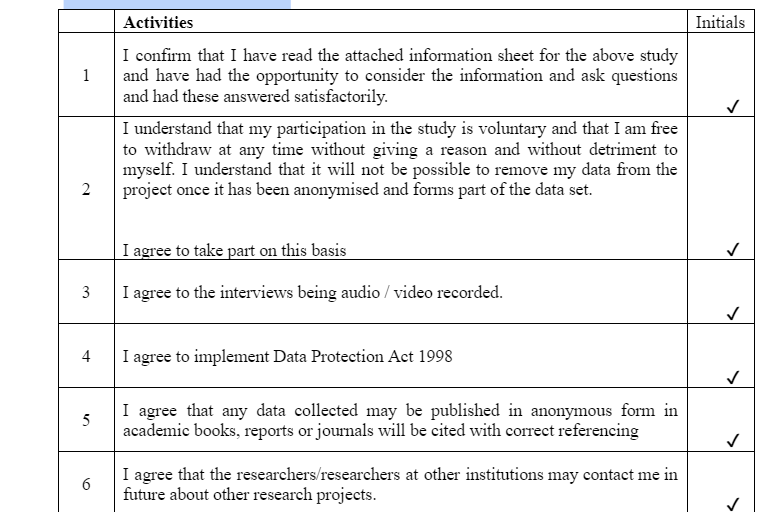





Appendix 3: Interview questions
1. Do you agree in managing inclusion and diversity?
2. How important is diversity to you?
3. What are your strategies to manage cultural diversity at the workplace?


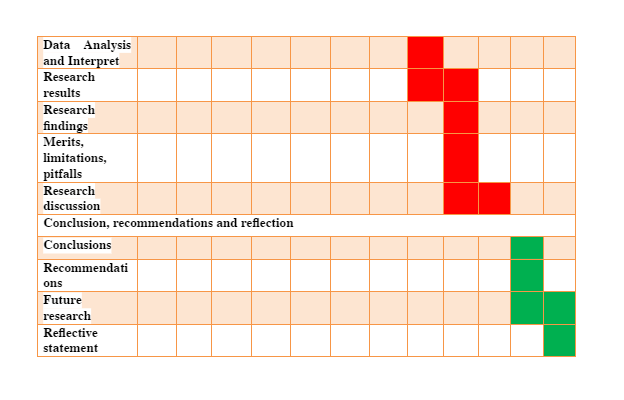
What Makes Us Unique
- 24/7 Customer Support
- 100% Customer Satisfaction
- No Privacy Violation
- Quick Services
- Subject Experts



